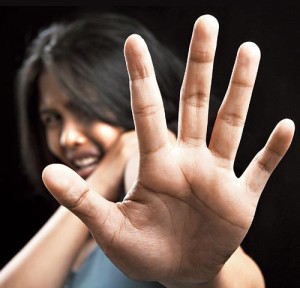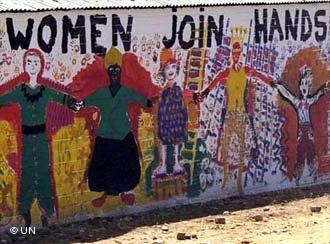 International Women’s Day celebrates those who identify as (and with) women. It is also a day for thinking about the achievements of women, as well as the things that hold them back – including, importantly, violence.
International Women’s Day celebrates those who identify as (and with) women. It is also a day for thinking about the achievements of women, as well as the things that hold them back – including, importantly, violence.
Violence against women occurs globally, and in many forms. This post is a spot check on the situation in Australia and the direction we are heading relative to the 1950s.
Violence against women 1950s style
Elizabeth Potter writes that her father controlled her mother “with fists and madness” and tells a haunting story of the situation for her family – socially isolated, living in the bush, lacking extended family – in the middle of last century when there were no relevant community services.
When Elizabeth’s mother tried to leave, the local doctor “committed her to a mental institution”. She was ‘treated’ with drugs and electric shock (ECT).
When she was discharged (a privilege requiring the consent of her husband) she “lived in fear of being taken away again”. She became suitably docile and effectively silenced: all her husband needed to do to exert his power was to threaten the consequences of “instability”.
The violence escalated.
Elizabeth Potter does not think much has changed over more than 50 years.
Kathryn Heyman’s story, or rather her mother’s story, also predates this century. Her parents stayed together for twenty-two years. “For twenty of those years [my father] repeatedly hit, kicked, pushed and pummelled [my mother]”.
“My father was a policeman. When my mother went to the police, she was told they could do nothing. When she went to family friends, she was told to keep quiet. When she went to the church, she was told to stay in her marriage.”
This was before the 1975 Family Law Act made divorce relatively straightforward (at least legally), and also before introduction of the Supporting Mothers Benefit (1973) and the opening of the first women’s shelter (1974).
As a child, Kathryn Heyman says she found it incomprehensible that her mother had nowhere to go, no one to listen, and no means of support.
“That dark country of the past…that country where women had nowhere to go…I can feel it creeping up again…We can’t go back”.
The bleak side of the current situation
It’s easy to see why Elizabeth Potter and Kathryn Heyman might be disturbed by the current situation in Australia. Community services are under threat despite hair-raising numbers of deaths (two women per week, on average, being killed by male partners and ex-partners, according to records by Destroy the Joint).
 We also have a Prime Minister who appears ignorant of the circumstances of women’s lives, but nonetheless appointed himself Minister for Women AND Minister for Aboriginal Affairs. He inspires no confidence that he has any real understanding of the issues for either of these overlapping groups, and the particular challenges of addressing violence against Aboriginal women are clearly beyond his capacity (see, for example, Amy McQuire on the complexities for Aboriginal women of breaking the silence on violence.)
We also have a Prime Minister who appears ignorant of the circumstances of women’s lives, but nonetheless appointed himself Minister for Women AND Minister for Aboriginal Affairs. He inspires no confidence that he has any real understanding of the issues for either of these overlapping groups, and the particular challenges of addressing violence against Aboriginal women are clearly beyond his capacity (see, for example, Amy McQuire on the complexities for Aboriginal women of breaking the silence on violence.)
Positive directions
On the upside, there is work being done towards change, and I will briefly mention the royal commission into family violence in Victoria, the report on family violence in Queensland, and Rosie Batty’s work as Australian of the Year.
1. Royal Commission into Family Violence in Victoria
The royal commission into family violence in Victoria is being led by Supreme Court Judge, Marcia Neave, who says her early life as a person with a disability gave her a fascination with justice at the broadest sense, and a concern with people who lack power in society.
She makes it clear the royal commission into violence is focused on women and children.
“Most victims of family violence are women and children, and that case will not have to be argued,” she says, although “the commission will hear from all groups, including men’s rights groups who often dispute the extent and causes of family violence.”
Submissions are sought from people with disabilities, older people, members of LGBTQI, migrant, and Indigenous communities. Emphasis is on how formal systems help (or don’t) and country areas are a particular focus because of the disproportionately high rates of violence occurring in them.
It will be interesting to see how this commission proceeds.
2. Queensland report
Another encouraging story comes from Queensland where a report with bipartisan support, Not Now, Not Ever: Putting an End to Domestic and Family Violence in Queensland, has recently been handed down. The report is based on feedback from women about their experiences of violence and systemic responses to them.
“The stories could have come from war zones,” says former governor-general, Dame Quentin Bryce, who headed the task force, “and women reported that the workings of the law and justice system too often serve to further traumatise them.”
The report makes 140 recommendations including establishment of specialised domestic violence courts.
Specialist understanding in specialised courts seems a development worth watching.
3. Rosie Batty as Australian of the Year
The backstory on violence against women in Queensland has its echoes across Australia, and the third encouraging sign has been the appointment of Rosie Batty as Australian of the Year.
Rosie’s son was killed by his father, and she has survived this tragedy to become an inspiring activist and campaigner. She likewise talks of the need for change in law and justice systems.
“To my mind,” she says, “there are two areas in need of significant review and better practice: They are the courts and police – the first points of contact for women suffering abuse.”
She does not want anyone else to lose a child to violence and promises she is “not the sort of person who will stand beside the prime minister and smile while nothing is done.”
She seems like a woman who will “make it happen” (the theme of this year’s International Women’s Day).
Conclusion
With a royal commission getting started, a major report passed down with concrete recommendations, and a person with lived experience of violence as Australian of the Year, are we making progress? Or is it a case of the more things change the more they stay the same?
Elizabeth Potter and Kathryn Heyman do not feel much has changed since the middle of last century. And they may be right. But at least the spotlight is on the dark spaces, and if change fails to occur it will be for reasons other than lack of awareness and knowlege.
Safety is a basic need. It should surely be taken at least as seriously in our households as it is on our roads.
 Celebrating International Women’s Day…but what about the violence?’ was originally published @ 2020 Social Justice and has been syndicated with permission.
Celebrating International Women’s Day…but what about the violence?’ was originally published @ 2020 Social Justice and has been syndicated with permission.
Our authors want to hear from you! Click to leave a comment
Related Posts






